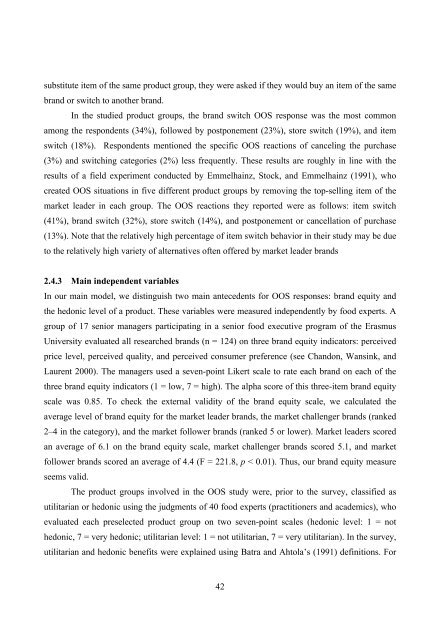Understanding Consumer Reactions to Assortment Unavailability
Understanding Consumer Reactions to Assortment Unavailability
Understanding Consumer Reactions to Assortment Unavailability
You also want an ePaper? Increase the reach of your titles
YUMPU automatically turns print PDFs into web optimized ePapers that Google loves.
substitute item of the same product group, they were asked if they would buy an item of the same<br />
brand or switch <strong>to</strong> another brand.<br />
In the studied product groups, the brand switch OOS response was the most common<br />
among the respondents (34%), followed by postponement (23%), s<strong>to</strong>re switch (19%), and item<br />
switch (18%). Respondents mentioned the specific OOS reactions of canceling the purchase<br />
(3%) and switching categories (2%) less frequently. These results are roughly in line with the<br />
results of a field experiment conducted by Emmelhainz, S<strong>to</strong>ck, and Emmelhainz (1991), who<br />
created OOS situations in five different product groups by removing the <strong>to</strong>p-selling item of the<br />
market leader in each group. The OOS reactions they reported were as follows: item switch<br />
(41%), brand switch (32%), s<strong>to</strong>re switch (14%), and postponement or cancellation of purchase<br />
(13%). Note that the relatively high percentage of item switch behavior in their study may be due<br />
<strong>to</strong> the relatively high variety of alternatives often offered by market leader brands<br />
2.4.3 Main independent variables<br />
In our main model, we distinguish two main antecedents for OOS responses: brand equity and<br />
the hedonic level of a product. These variables were measured independently by food experts. A<br />
group of 17 senior managers participating in a senior food executive program of the Erasmus<br />
University evaluated all researched brands (n = 124) on three brand equity indica<strong>to</strong>rs: perceived<br />
price level, perceived quality, and perceived consumer preference (see Chandon, Wansink, and<br />
Laurent 2000). The managers used a seven-point Likert scale <strong>to</strong> rate each brand on each of the<br />
three brand equity indica<strong>to</strong>rs (1 = low, 7 = high). The alpha score of this three-item brand equity<br />
scale was 0.85. To check the external validity of the brand equity scale, we calculated the<br />
average level of brand equity for the market leader brands, the market challenger brands (ranked<br />
2–4 in the category), and the market follower brands (ranked 5 or lower). Market leaders scored<br />
an average of 6.1 on the brand equity scale, market challenger brands scored 5.1, and market<br />
follower brands scored an average of 4.4 (F = 221.8, p < 0.01). Thus, our brand equity measure<br />
seems valid.<br />
The product groups involved in the OOS study were, prior <strong>to</strong> the survey, classified as<br />
utilitarian or hedonic using the judgments of 40 food experts (practitioners and academics), who<br />
evaluated each preselected product group on two seven-point scales (hedonic level: 1 = not<br />
hedonic, 7 = very hedonic; utilitarian level: 1 = not utilitarian, 7 = very utilitarian). In the survey,<br />
utilitarian and hedonic benefits were explained using Batra and Ah<strong>to</strong>la’s (1991) definitions. For<br />
42

















